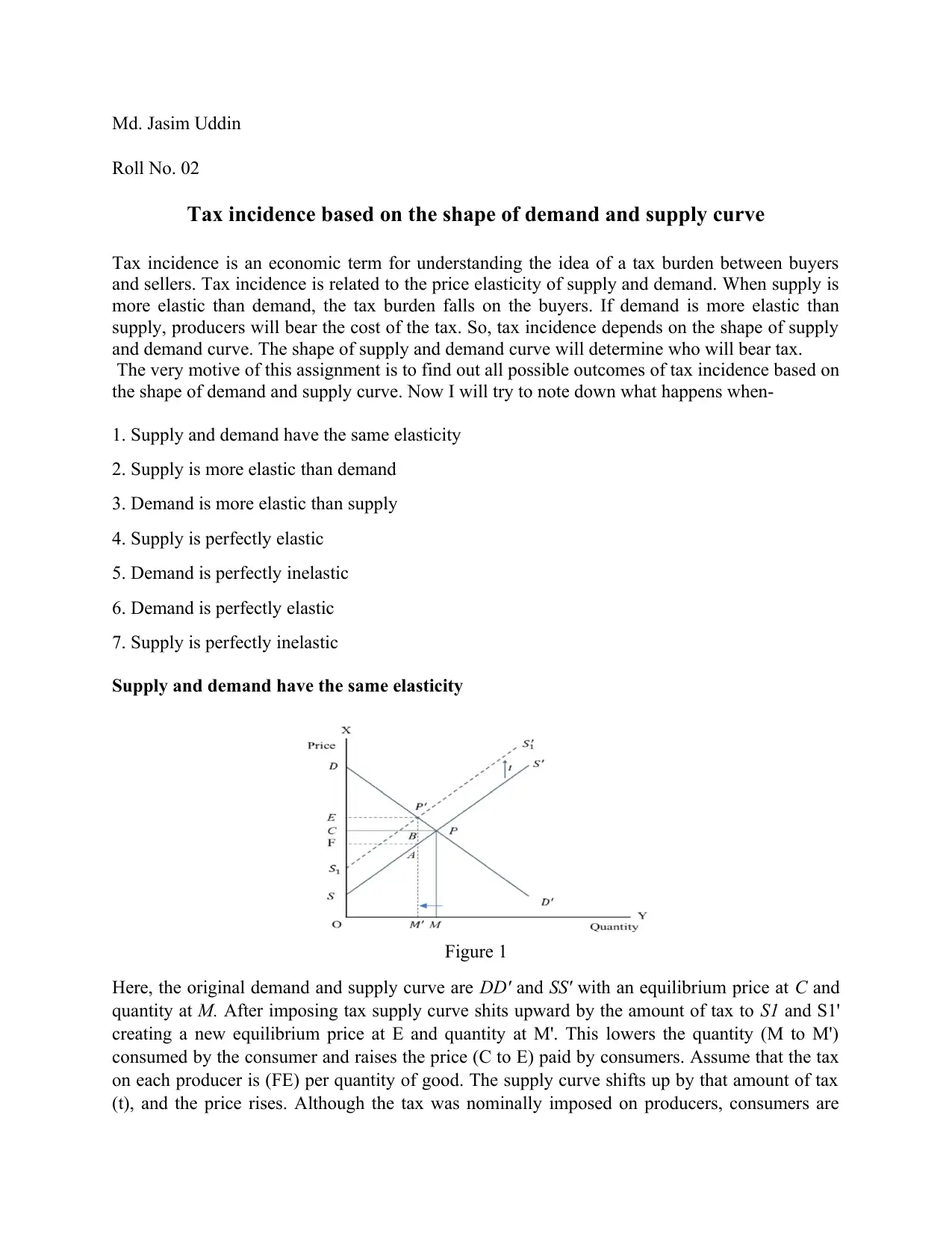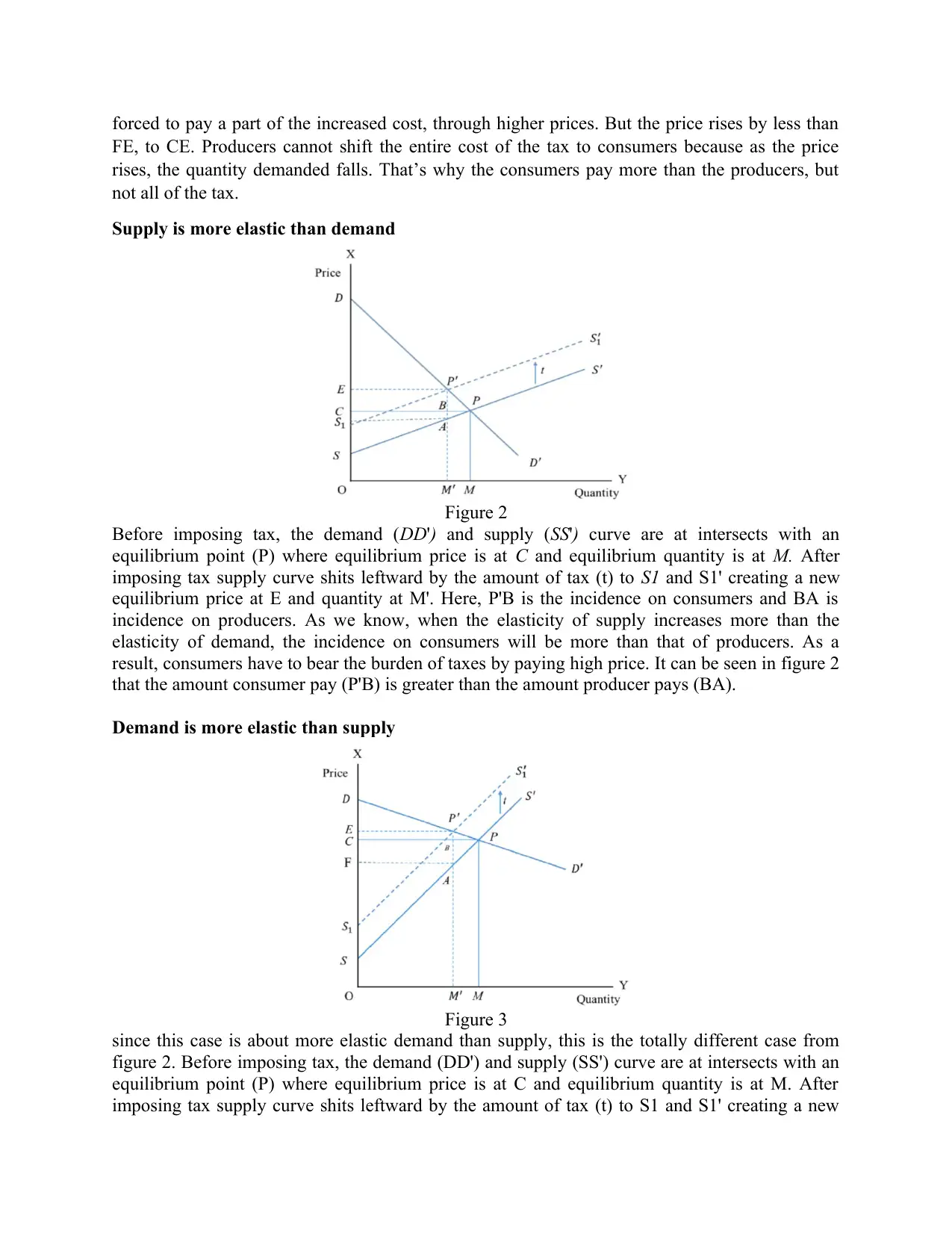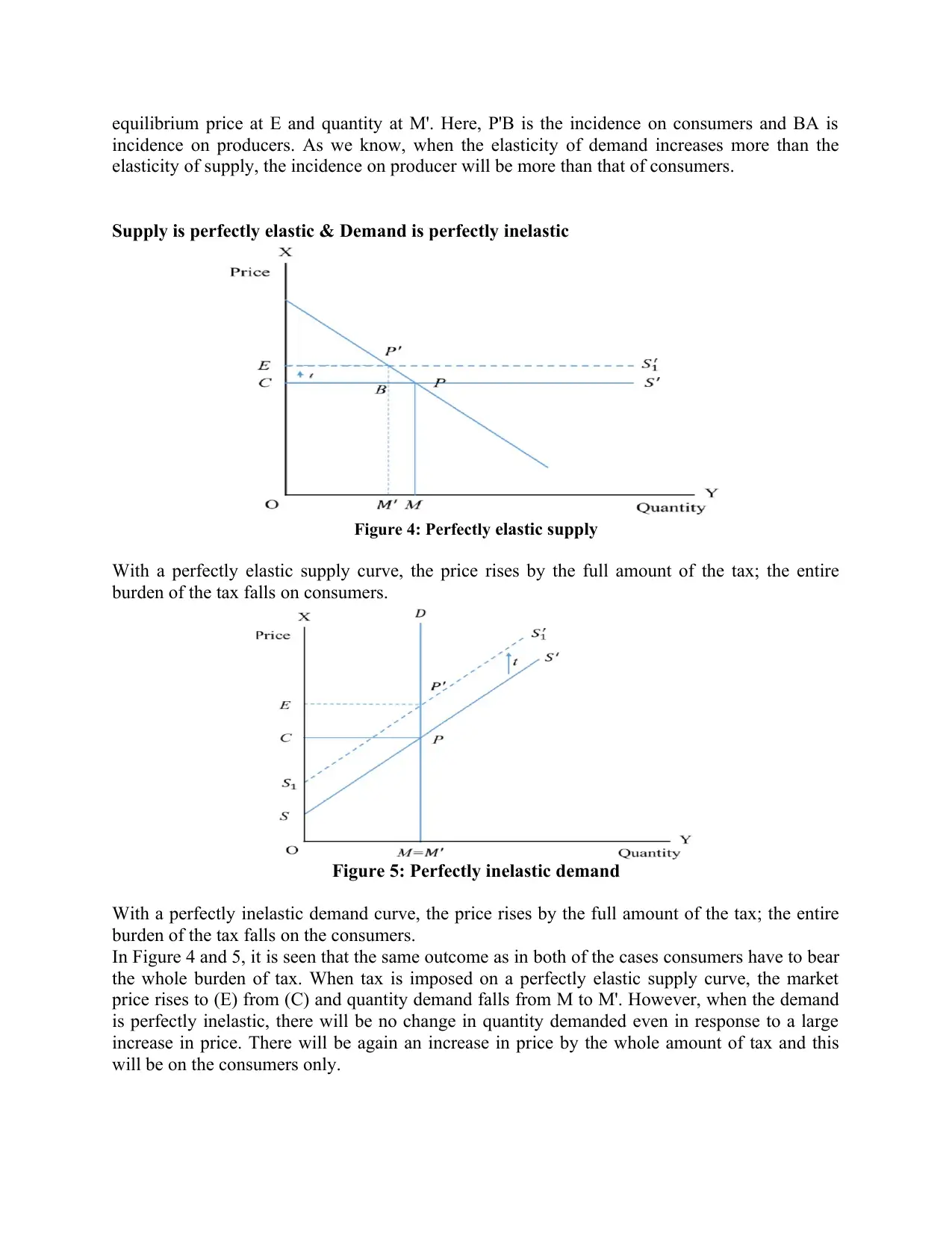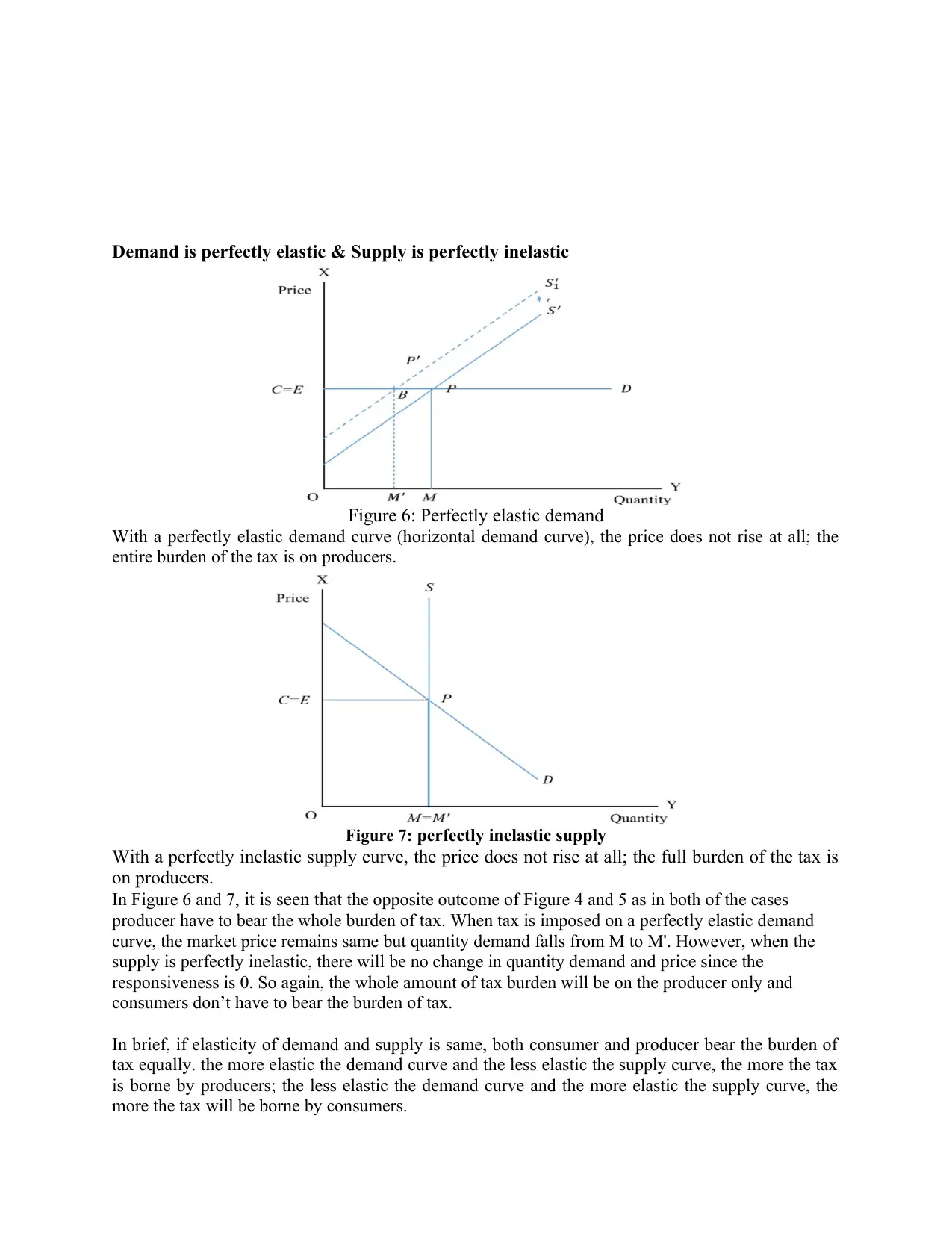Tax Incidence Analysis: Impact of Elasticity on Burden Sharing
VerifiedAdded on 2021/11/24
|4
|1168
|43
Homework Assignment
AI Summary
This assignment, completed by Md. Jasim Uddin, explores the concept of tax incidence, which examines how the burden of a tax is distributed between buyers and sellers. The analysis focuses on how the elasticity of supply and demand curves influences this distribution. The assignment investigates several scenarios, including when supply and demand have the same elasticity, when supply is more elastic than demand, and when demand is more elastic than supply. It also examines the extreme cases of perfectly elastic and inelastic supply and demand curves. The key finding is that the relative elasticity of supply and demand determines who bears the greater share of the tax burden: if demand is more elastic, producers bear more of the tax, while if supply is more elastic, consumers bear more. The assignment uses graphical representations to illustrate the different outcomes and concludes by summarizing the relationship between elasticity and tax burden distribution.

Md. Jasim Uddin
Roll No. 02
Tax incidence based on the shape of demand and supply curve
Tax incidence is an economic term for understanding the idea of a tax burden between buyers
and sellers. Tax incidence is related to the price elasticity of supply and demand. When supply is
more elastic than demand, the tax burden falls on the buyers. If demand is more elastic than
supply, producers will bear the cost of the tax. So, tax incidence depends on the shape of supply
and demand curve. The shape of supply and demand curve will determine who will bear tax.
The very motive of this assignment is to find out all possible outcomes of tax incidence based on
the shape of demand and supply curve. Now I will try to note down what happens when-
1. Supply and demand have the same elasticity
2. Supply is more elastic than demand
3. Demand is more elastic than supply
4. Supply is perfectly elastic
5. Demand is perfectly inelastic
6. Demand is perfectly elastic
7. Supply is perfectly inelastic
Supply and demand have the same elasticity
Figure 1
Here, the original demand and supply curve are DD' and SS' with an equilibrium price at C and
quantity at M. After imposing tax supply curve shits upward by the amount of tax to S1 and S1'
creating a new equilibrium price at E and quantity at M'. This lowers the quantity (M to M')
consumed by the consumer and raises the price (C to E) paid by consumers. Assume that the tax
on each producer is (FE) per quantity of good. The supply curve shifts up by that amount of tax
(t), and the price rises. Although the tax was nominally imposed on producers, consumers are
Roll No. 02
Tax incidence based on the shape of demand and supply curve
Tax incidence is an economic term for understanding the idea of a tax burden between buyers
and sellers. Tax incidence is related to the price elasticity of supply and demand. When supply is
more elastic than demand, the tax burden falls on the buyers. If demand is more elastic than
supply, producers will bear the cost of the tax. So, tax incidence depends on the shape of supply
and demand curve. The shape of supply and demand curve will determine who will bear tax.
The very motive of this assignment is to find out all possible outcomes of tax incidence based on
the shape of demand and supply curve. Now I will try to note down what happens when-
1. Supply and demand have the same elasticity
2. Supply is more elastic than demand
3. Demand is more elastic than supply
4. Supply is perfectly elastic
5. Demand is perfectly inelastic
6. Demand is perfectly elastic
7. Supply is perfectly inelastic
Supply and demand have the same elasticity
Figure 1
Here, the original demand and supply curve are DD' and SS' with an equilibrium price at C and
quantity at M. After imposing tax supply curve shits upward by the amount of tax to S1 and S1'
creating a new equilibrium price at E and quantity at M'. This lowers the quantity (M to M')
consumed by the consumer and raises the price (C to E) paid by consumers. Assume that the tax
on each producer is (FE) per quantity of good. The supply curve shifts up by that amount of tax
(t), and the price rises. Although the tax was nominally imposed on producers, consumers are
Paraphrase This Document
Need a fresh take? Get an instant paraphrase of this document with our AI Paraphraser

forced to pay a part of the increased cost, through higher prices. But the price rises by less than
FE, to CE. Producers cannot shift the entire cost of the tax to consumers because as the price
rises, the quantity demanded falls. That’s why the consumers pay more than the producers, but
not all of the tax.
Supply is more elastic than demand
Figure 2
Before imposing tax, the demand (DD') and supply (SS') curve are at intersects with an
equilibrium point (P) where equilibrium price is at C and equilibrium quantity is at M. After
imposing tax supply curve shits leftward by the amount of tax (t) to S1 and S1' creating a new
equilibrium price at E and quantity at M'. Here, P'B is the incidence on consumers and BA is
incidence on producers. As we know, when the elasticity of supply increases more than the
elasticity of demand, the incidence on consumers will be more than that of producers. As a
result, consumers have to bear the burden of taxes by paying high price. It can be seen in figure 2
that the amount consumer pay (P'B) is greater than the amount producer pays (BA).
Demand is more elastic than supply
Figure 3
since this case is about more elastic demand than supply, this is the totally different case from
figure 2. Before imposing tax, the demand (DD') and supply (SS') curve are at intersects with an
equilibrium point (P) where equilibrium price is at C and equilibrium quantity is at M. After
imposing tax supply curve shits leftward by the amount of tax (t) to S1 and S1' creating a new
FE, to CE. Producers cannot shift the entire cost of the tax to consumers because as the price
rises, the quantity demanded falls. That’s why the consumers pay more than the producers, but
not all of the tax.
Supply is more elastic than demand
Figure 2
Before imposing tax, the demand (DD') and supply (SS') curve are at intersects with an
equilibrium point (P) where equilibrium price is at C and equilibrium quantity is at M. After
imposing tax supply curve shits leftward by the amount of tax (t) to S1 and S1' creating a new
equilibrium price at E and quantity at M'. Here, P'B is the incidence on consumers and BA is
incidence on producers. As we know, when the elasticity of supply increases more than the
elasticity of demand, the incidence on consumers will be more than that of producers. As a
result, consumers have to bear the burden of taxes by paying high price. It can be seen in figure 2
that the amount consumer pay (P'B) is greater than the amount producer pays (BA).
Demand is more elastic than supply
Figure 3
since this case is about more elastic demand than supply, this is the totally different case from
figure 2. Before imposing tax, the demand (DD') and supply (SS') curve are at intersects with an
equilibrium point (P) where equilibrium price is at C and equilibrium quantity is at M. After
imposing tax supply curve shits leftward by the amount of tax (t) to S1 and S1' creating a new

equilibrium price at E and quantity at M'. Here, P'B is the incidence on consumers and BA is
incidence on producers. As we know, when the elasticity of demand increases more than the
elasticity of supply, the incidence on producer will be more than that of consumers.
Supply is perfectly elastic & Demand is perfectly inelastic
Figure 4: Perfectly elastic supply
With a perfectly elastic supply curve, the price rises by the full amount of the tax; the entire
burden of the tax falls on consumers.
Figure 5: Perfectly inelastic demand
With a perfectly inelastic demand curve, the price rises by the full amount of the tax; the entire
burden of the tax falls on the consumers.
In Figure 4 and 5, it is seen that the same outcome as in both of the cases consumers have to bear
the whole burden of tax. When tax is imposed on a perfectly elastic supply curve, the market
price rises to (E) from (C) and quantity demand falls from M to M'. However, when the demand
is perfectly inelastic, there will be no change in quantity demanded even in response to a large
increase in price. There will be again an increase in price by the whole amount of tax and this
will be on the consumers only.
incidence on producers. As we know, when the elasticity of demand increases more than the
elasticity of supply, the incidence on producer will be more than that of consumers.
Supply is perfectly elastic & Demand is perfectly inelastic
Figure 4: Perfectly elastic supply
With a perfectly elastic supply curve, the price rises by the full amount of the tax; the entire
burden of the tax falls on consumers.
Figure 5: Perfectly inelastic demand
With a perfectly inelastic demand curve, the price rises by the full amount of the tax; the entire
burden of the tax falls on the consumers.
In Figure 4 and 5, it is seen that the same outcome as in both of the cases consumers have to bear
the whole burden of tax. When tax is imposed on a perfectly elastic supply curve, the market
price rises to (E) from (C) and quantity demand falls from M to M'. However, when the demand
is perfectly inelastic, there will be no change in quantity demanded even in response to a large
increase in price. There will be again an increase in price by the whole amount of tax and this
will be on the consumers only.
⊘ This is a preview!⊘
Do you want full access?
Subscribe today to unlock all pages.

Trusted by 1+ million students worldwide

Demand is perfectly elastic & Supply is perfectly inelastic
Figure 6: Perfectly elastic demand
With a perfectly elastic demand curve (horizontal demand curve), the price does not rise at all; the
entire burden of the tax is on producers.
Figure 7: perfectly inelastic supply
With a perfectly inelastic supply curve, the price does not rise at all; the full burden of the tax is
on producers.
In Figure 6 and 7, it is seen that the opposite outcome of Figure 4 and 5 as in both of the cases
producer have to bear the whole burden of tax. When tax is imposed on a perfectly elastic demand
curve, the market price remains same but quantity demand falls from M to M'. However, when the
supply is perfectly inelastic, there will be no change in quantity demand and price since the
responsiveness is 0. So again, the whole amount of tax burden will be on the producer only and
consumers don’t have to bear the burden of tax.
In brief, if elasticity of demand and supply is same, both consumer and producer bear the burden of
tax equally. the more elastic the demand curve and the less elastic the supply curve, the more the tax
is borne by producers; the less elastic the demand curve and the more elastic the supply curve, the
more the tax will be borne by consumers.
Figure 6: Perfectly elastic demand
With a perfectly elastic demand curve (horizontal demand curve), the price does not rise at all; the
entire burden of the tax is on producers.
Figure 7: perfectly inelastic supply
With a perfectly inelastic supply curve, the price does not rise at all; the full burden of the tax is
on producers.
In Figure 6 and 7, it is seen that the opposite outcome of Figure 4 and 5 as in both of the cases
producer have to bear the whole burden of tax. When tax is imposed on a perfectly elastic demand
curve, the market price remains same but quantity demand falls from M to M'. However, when the
supply is perfectly inelastic, there will be no change in quantity demand and price since the
responsiveness is 0. So again, the whole amount of tax burden will be on the producer only and
consumers don’t have to bear the burden of tax.
In brief, if elasticity of demand and supply is same, both consumer and producer bear the burden of
tax equally. the more elastic the demand curve and the less elastic the supply curve, the more the tax
is borne by producers; the less elastic the demand curve and the more elastic the supply curve, the
more the tax will be borne by consumers.
1 out of 4
Related Documents
Your All-in-One AI-Powered Toolkit for Academic Success.
+13062052269
info@desklib.com
Available 24*7 on WhatsApp / Email
![[object Object]](/_next/static/media/star-bottom.7253800d.svg)
Unlock your academic potential
Copyright © 2020–2025 A2Z Services. All Rights Reserved. Developed and managed by ZUCOL.





